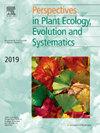Measuring standardized functional leaf traits of aquatic carnivorous plants – challenges and opportunities
IF 2.9
3区 环境科学与生态学
Q1 ECOLOGY
Perspectives in Plant Ecology Evolution and Systematics
Pub Date : 2024-09-21
DOI:10.1016/j.ppees.2024.125826
引用次数: 0
Abstract
Aquatic carnivorous plants (ACP) are an important component of humic nutrient-poor freshwater environments. However, these habitats are facing multiple impacts that ultimately lead to habitat degradation and declining ACP populations. Functional traits, particularly those within the leaf economics spectrum, are a valuable tool for studying plant adaptation strategies and plasticity. Given their unique morphological structure, ACP are essentially excluded from functional comparisons, which potentially limits our knowledge about the ecological roles of these species compared to non-carnivorous ones. In this study, we developed a protocol for measuring the leaf functional traits of ACP (leaf fresh and dry weight, leaf area, leaf dry matter content, specific leaf area, leaf pigment content, leaf phosphorus, nitrogen and carbon contents), and carnivory-related traits (number of traps and investment in carnivory). We measured 15 traits in seven ACP species (Aldrovanda vesiculosa, Utricularia australis, U. bremii, U. intermedia, U. ochroleuca, U. stygia, U. vulgaris), grown in the outdoor collection of aquatic and wetland plants of the Institute of Botany CAS at Třeboň, the Czech Republic. We used the functional traits of other macrophyte groups/species (lemnids, Nuphar lutea, Ceratophyllum demersum), collected with a similar methodology, to assess the comparability of ACP traits. We identified the “functional unit”, a modular structure, including one leaf node, plus an internode, which performs the function of a leaf in ACP, and selected its position along the stem to reflect species-specific growth rates. We collected 714 new trait records for the target ACP. Based on a multivariate trait space representation (PCA), ACP were distinct from the other macrophyte groups/species, which highlights these species’ structural and physiological peculiarities. Nonetheless, ACP entirely overlapped the comparison data along the first PCA axis, and most of the traits lay within the ranges observed for other macrophyte groups/species, which demonstrates the comparability of the ACP traits measured by the new protocol. Applying this protocol in ecological studies could shed light on the adaptations of ACP to environmental variability, with important conservation implications.
测量水生食肉植物的标准化功能叶片特征--挑战与机遇
水生食肉植物(ACP)是腐殖质贫营养淡水环境的重要组成部分。然而,这些栖息地正面临着多种影响,最终导致栖息地退化和水生食肉植物数量减少。功能性状,尤其是叶片经济学范围内的功能性状,是研究植物适应策略和可塑性的宝贵工具。鉴于其独特的形态结构,ACP基本上被排除在功能比较之外,这可能会限制我们对这些物种与非肉食性物种相比的生态作用的了解。在这项研究中,我们制定了一套方案,用于测量 ACP 的叶片功能性状(叶片鲜重和干重、叶面积、叶片干物质含量、比叶面积、叶片色素含量、叶片磷、氮和碳含量)以及肉食性相关性状(诱捕器数量和肉食投资)。我们测量了生长在捷克共和国特热波恩中科院植物研究所水生和湿地植物室外收集区的七个 ACP 物种(Aldrovanda vesiculosa、Utricularia australis、U. bremii、U. intermedia、U. ochroleuca、U. stygia、U. vulgaris)的 15 个性状。我们使用类似方法收集的其他大型水生植物类群/物种(lemnids、Nuphar lutea、Ceratophyllum demersum)的功能特征,以评估 ACP 特征的可比性。我们确定了 "功能单元",这是一种模块化结构,包括一个叶节和一个节间,在 ACP 中发挥叶片的功能,并选择了其沿茎的位置,以反映物种特有的生长速度。我们为目标 ACP 收集了 714 条新的性状记录。根据多元性状空间表示法(PCA),ACP与其他大型植物类群/物种截然不同,这凸显了这些物种在结构和生理上的特殊性。尽管如此,ACP 在第一个 PCA 轴上与比较数据完全重叠,而且大多数性状都在其他大型植物类群/物种的观察范围内,这表明新方案测量的 ACP 性状具有可比性。在生态学研究中应用该方案可以揭示 ACP 对环境变异的适应性,对保护具有重要意义。
本文章由计算机程序翻译,如有差异,请以英文原文为准。
求助全文
约1分钟内获得全文
求助全文
来源期刊
CiteScore
6.50
自引率
0.00%
发文量
28
审稿时长
67 days
期刊介绍:
Perspectives in Plant Ecology, Evolution and Systematics (PPEES) publishes outstanding and thought-provoking articles of general interest to an international readership in the fields of plant ecology, evolution and systematics. Of particular interest are longer, in-depth articles that provide a broad understanding of key topics in the field. There are six issues per year.
The following types of article will be considered:
Full length reviews
Essay reviews
Longer research articles
Meta-analyses
Foundational methodological or empirical papers from large consortia or long-term ecological research sites (LTER).

 求助内容:
求助内容: 应助结果提醒方式:
应助结果提醒方式:


